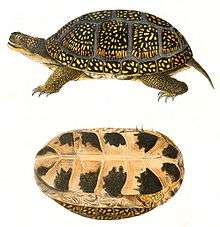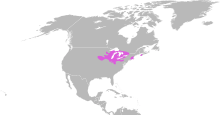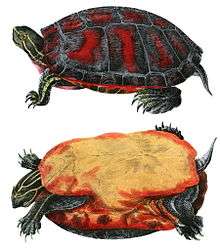Blanding's turtle
| Blanding's turtle | |
|---|---|
 | |
| Scientific classification | |
| Kingdom: | Animalia |
| Phylum: | Chordata |
| Subphylum: | Vertebrata |
| Class: | Reptilia |
| Order: | Testudines |
| Family: | Emydidae |
| Subfamily: | Emydinae |
| Genus: | Emys or Emydoidea[1][3] |
| Species: | E. blandingii |
| Binomial name | |
| Emys blandingii or Emydoidea blandingii[1][4] (Holbrook, 1838)[4] | |
 | |
| The range of Blanding's turtle | |
| Synonyms[4][5][6] | |
| |
Blanding's turtle (Emys blandingii or Emydoidea blandingii )[1][4] is a semi-aquatic turtle of the family Emydidae. This North American turtle is considered to be an endangered species throughout much of its range.[7]
Taxonomy
There are differences of opinion as to the genus for this species; both Emys and Emydoidea occur in published sources in 2009, 2010, and 2011.[1][3]
Etymology
Both the specific name, blandingii, and the common name, Blanding's turtle, are in honor of American naturalist Dr. William Blanding (1773-1857).[8]
Description
Blanding's turtle is a medium-sized turtle with an average shell length of approximately 18 to 23 cm (7.1 to 9.1 in) with a maximum of 25.5 cm (10.0 in). A distinguishing feature of this turtle is the bright yellow chin and throat. The carapace, or upper shell, is domed, but slightly flattened along the midline, and is oblong when viewed from above. The carapace is speckled with numerous yellow or light-colored flecks or streaks on a dark background. The plastron, or lower shell, is yellow with dark blotches symmetrically arranged. The head and legs are dark, and usually speckled or mottled with yellow. Blanding's turtle is also called the "semi-box" turtle, for although the plastron is hinged, the plastral lobes do not shut as tight as the box turtle's.
Reproduction
Blanding's turtles take 14–20 years to reach sexual maturity. Mating probably occurs in April and early May with nesting beginning in early June and lasting throughout the month.[9] The clutch size varies from region to region. In New York, the clutch size ranges from 5–12 eggs with an average of eight.
Behavior and life span
Blanding's turtles overwinter under or near water, in mud, or under vegetation or debris. During the nesting season, a female Blanding's turtle may be found more than a kilometer from where it hibernated. It is omnivorous, eating crustaceans and other invertebrates, fish, frogs, crayfish, carrion, berries, and vegetable debris. It is capable of catching live fish. Blanding's turtle may live to be 80 years.
Blanding's turtle is a timid turtle and may plunge into water and remain on the bottom for hours when alarmed. If away from water, the turtle will withdraw into its shell. It is very gentle and rarely attempts to bite. It is very agile and a good swimmer.
Blanding's turtles do not appear to age once they have reached adulthood. When compared to, for example, a 20-year-old turtle, a 70-year-old exhibits negligible senescence, and may, in fact, be "better at scouting out the good nesting places and also produce more progeny".
Distribution and habitat

This species' range centres on the Great Lakes, and extends from central Nebraska and Minnesota (where it twice failed to become the state reptile)[10] eastward through southern Ontario and the south shore of Lake Erie as far east as northern New York. There are also isolated populations in southeastern New York (Dutchess County), New England and Nova Scotia.[11] Its general habitat is wetlands with clean shallow water. It is known to bask on logs, and will wander far from water, particularly when nesting. They generally nest in sunny areas, with well drained soil. Younger turtles may bask on sedge and alder hummocks. Young will often travel far in search of mating sites, new habitat, or new food sources, as do elder turtles.
Conservation status
The primary threat to Blanding's turtle is habitat fragmentation and destruction as well as nest predation by unnaturally large populations of predators.[2] It is listed as an endangered species on the IUCN Red List[2] as endangered in some U.S. states, and as either threatened or endangered throughout Canada, though it has no federal status in the U.S. The Blanding's turtle is also not currently listed under CITES (the Convention on International Trade in Endangered Species of Wild Fauna and Flora) protection, but is under consideration as of 2013.[12] The U.S. states in which it is considered endangered are Indiana,[13] Illinois, Missouri,[14] Maine, New Hampshire, Massachusetts, and South Dakota.[15] It is considered threatened in New York.[16] Blanding's turtle is also fully protected in Michigan as a special concern species, and is not to be collected or harmed.[17] In Nebraska, this turtle is uncommon in the eastern portion of the state, but common to abundant in the Sand Hills region lakes, ponds, and streams. In Canada, the Great Lakes-St. Lawrence River population in Ontario and Quebec is federally threatened[18] and the Nova Scotia population is endangered.[19]
References
- 1 2 3 4 5 Rhodin 2011, p. 000.185
- 1 2 3 van Dijk, P.P.; Rhodin, A.G.J. (2010). "Emydoidea blandingii". IUCN Red List of Threatened Species. Version 2011.1. International Union for Conservation of Nature. Retrieved 8 October 2011.
- 1 2 Rhodin 2010, pp. 000.138–000.139
- 1 2 3 4 Rhodin 2010, pp. 000.105–000.106
- ↑ Fritz, Uwe, and Peter Havaš. 2007. Checklist of Chelonians of the World. Vertebrate Zoology 57 (2): 149-368. (Emydoidea blandingii, pp. 180-181.)
- ↑ Emydoidea blandingii, The Reptile Database. www.reptile-database.org.
- ↑ "Blanding's Turtle". Environmental Laboratory, Engineer Research and Development Center, U.S. Army Corps of Engineers.
- ↑ Beolens, B.; Watkins, M.; Grayson, M. (2011). The Eponym Dictionary of Reptiles. Baltimore: Johns Hopkins University Press. p. 27. ISBN 978-1-4214-0135-5.
- ↑ MacCulloch, R.D.; Weller, W.F. (1988). "Reproduction in a Lake Erie population of Blanding's Turtle, Emydoidea blandingii". Canadian Journal of Zoology. 66: 2317–2319. doi:10.1139/z88-345.
- ↑ "Minnesota State Symbols—Unofficial, Proposed, or Facetious". Minnesota State Legislature. Retrieved 2011-02-25.
- ↑ Ernst, C.H.; Barbour, R.W.; Lovich, J.E. (1994). Turtles of the United States and Canada. Washington: Smithsonian Institution. p. 242.
- ↑ "CONSIDERATION OF PROPOSALS FOR AMENDMENTS TO APPENDICES I AND II" (PDF).
- ↑ Indiana Legislative Services Agency (2011). "312 IAC 9-5-4: Endangered species of reptiles and amphibians". Indiana Administrative Code. Retrieved 28 Apr 2012.
- ↑ "Endangered Species in the Field Guide". Discover Nature Field Guide. MO Dept. of Conservation. Retrieved 4 September 2015.
- ↑ "A Field Guide to South Dakota Turtles" (PDF). South Dakota State University.
- ↑ "Blanding's Turtle Fact Sheet". New York State Department of Environmental Conservation. Retrieved 22 May 2015.
- ↑ Blanding's Turtle (Emys blandingii), DNR, Michigan
- ↑ Blanding's Turtle Great Lakes / St. Lawrence population, Species At Risk Public Registry
- ↑ Blanding's Turtle Nova Scotia Population, Species At Risk Public Registry.
- Bibliography
- Rhodin, Anders G.J.; van Dijk; Peter Paul; Iverson, John B.; Shaffer, H. Bradley (2010-12-14). "Turtles of the World 2010 Update: Annotated Checklist of Taxonomy, Synonymy, Distribution and Conservation Status" (PDF). Archived from the original (pdf) on 2010-12-15. Retrieved 2010-12-15.
- Rhodin, Anders G.J.; van Dijk; Peter Paul; Inverson, John B.; Shaffer, H. Bradley; Roger, Bour (2011-12-31). "Turtles of the world, 2011 update: Annotated checklist of taxonomy, synonymy, distribution and conservation status" (PDF). Chelonian Research Monographs. 5. Archived from the original (PDF) on 2012-01-22.
Further reading
- Behler JL, King FW. (1979). The Audubon Society Field Guide to North American Reptiles and Amphibians. New York: Knopf. 743 pp. ISBN 0-394-50824-6. (Emydoidea blandingi [sic], p. 458 + Plate 291).
- Conant R. (1975). A Field Guide to Reptiles and Amphibians of Eastern and Central North America, Second Edition. Boston: Houghton Mifflin. xviii + 429 pp. ISBN 0-395-19979-4 (hardcover), ISBN 0-395-19977-8 (paperback). (Emydoidea blandingi [sic], p. 71 + Plates 5,7 + Map 26).
- Goin CJ, Goin OB, Zug GR. (1978). Introduction to Herpetology, Third Edition. San Francisco: W.H. Freeman. xi + 378 pp. ISBN 0-7167-0020-4. (Genus Emydoidea, p. 259).
- Holbrook JE. (1838). North American Herpetology; or, A Description of the Reptiles Inhabiting the United States. Vol. III. Philadelphia: J. Dobson. 122 pp. + Plates I-XXX. (Cistuda blandingii, pp. 35–38 + Plate V).
- Smith HM, Brodie ED Jr. (1982). Reptiles of North America: A Guide to Field Identification. New York: Golden Press. 240 pp. ISBN 0-307-13666-3. (Emydoidea blandingi [sic], pp. 44–45).
- Stejneger L, Barbour T. (1917). A Check List of North American Amphibians and Reptiles. Cambridge, Massachusetts: Harvard University Press. 125 pp. (Emys blandingii, p. 115).
External links
| Wikimedia Commons has media related to Emydoidea blandingii. |
- Blanding's Turtle Fact Sheet
- Michigan Dept. of Natural Resources Blanding's Turtle (Emys blandingii)
- Blanding's Turtle – Emydoidea blandingii Species account from the Iowa Reptile and Amphibian Field Guide
- Blanding's Turtle, Natural Resources Canada
- Blanding's Turtle, Ontario Ministry of Natural Resources

